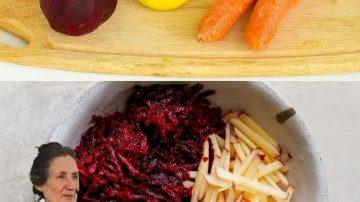Sumac is a vibrant, crimson-colored spice derived from the dried and ground berries of the $\text{Rhus coriaria}$ shrub. A staple in Middle Eastern and Mediterranean cuisine, it is prized for its tangy, lemon-like flavor and is celebrated in traditional medicine for its powerful antioxidant and anti-inflammatory properties.
Here are 20 potential benefits (supported by preliminary research) and easy ways to incorporate sumac into your kitchen routine.

Part 1: 20 Potential Health Benefits of Sumac
The health advantages of sumac are primarily driven by its rich content of $\text{polyphenols}$, $\text{flavonoids}$ (like $\text{quercetin}$), and $\text{anthocyanins}$.
Metabolic & Cardiovascular Health

- Regulates Blood Sugar: May help lower fasting blood sugar levels and improve overall blood sugar control in people with Type 2 diabetes.
- Improves Insulin Sensitivity: Some research suggests it can decrease insulin resistance, helping the body process glucose more effectively.
- Lowers Cholesterol: Its $\text{polyphenol}$ content may help reduce total and $\text{LDL}$ ($\text{bad}$) cholesterol levels, supporting heart health.
- Reduces Cardiovascular Risk: Daily intake of sumac may lower the risk of cardiovascular disease, especially in diabetic patients.
- Anti-Hypertensive Effects: Traditional use and some studies suggest it may help support healthy blood pressure.
Anti-Inflammatory & Antioxidant Action
- Powerful Antioxidant: High $\text{ORAC}$ (Oxygen Radical Absorbance Capacity) value, meaning it effectively neutralizes cell-damaging free radicals.
- Fights Inflammation: Potent $\text{anti-inflammatory}$ compounds (like $\text{gallic}$ $\text{acid}$) can help alleviate symptoms of inflammatory conditions like arthritis.
- Reduces Oxidative Stress: Protects cells and $\text{DNA}$ from damage, which is a key factor in aging and chronic illness.
- Alleviates Muscle Pain: Preliminary studies indicate it may help reduce exercise-induced muscle pain and soreness due to its antioxidant effect on muscle damage.
- Potential Anti-Cancer Effects: Its active compounds have been studied for their ability to impede cancer cell growth and promote programmed cell death ($\text{apoptosis}$).
Digestive & Immune Support

- Antimicrobial Properties: Exhibits activity against various bacteria (including some antibiotic-resistant strains) and fungi.
- Aids Digestion: Traditionally used to manage and relieve symptoms of diarrhea and gastrointestinal distress.
- Relieves Gastrointestinal Spasms: Used in folk medicine for its antispasmodic effects in the digestive tract.
- Source of Fiber: Contains dietary fiber, which promotes healthy digestion and gut microbiome balance.
- Boosts Immunity: Rich in $\text{Vitamin C}$ and other $\text{antioxidants}$ that strengthen the body’s defenses against illness.
Nutritional & Traditional Benefits
- Source of Healthy Fats: Contains unsaturated fats, including $\text{oleic}$ $\text{acid}$ (heart health) and $\text{linoleic}$ $\text{acid}$ (skin health).
- Provides $\text{Vitamin C}$: A natural source of this vitamin, which supports $\text{collagen}$ synthesis and immunity.
- Traditional Remedy for Hemorrhoids: Used topically in some folk medicine for its astringent and $\text{anti-inflammatory}$ properties.
- Supports Skin Health: The antioxidants help protect the skin from free radical damage.
- Historical Souring Agent: Before lemons were widely available, sumac was used by the Romans and others to add essential tartness to food.
Part 2: Easy Ways to Use Sumac at Home
Sumac is incredibly versatile and can be used in savory dishes, sweet treats, and beverages. Use it anywhere you want a bright, tart flavor without adding liquid moisture.
| Usage Category | Easy Home Application | Pro Tip |
| Finishing Spice | Sprinkle generously over dips like hummus, $\text{labneh}$ (strained yogurt), or baba ghanoush. | The vibrant red color makes it an excellent, low-sodium substitute for paprika as a garnish. |
| Salads & Dressings | Essential ingredient for $\text{Fattoush}$ salad. Mix with olive oil, mint, and lemon juice for a tangy vinaigrette. | Use a pinch on simple sliced tomato and cucumber salads for instant Mediterranean brightness. |
| Meat & Protein | Use in dry rubs for chicken, lamb, or fish before grilling or roasting. | The tartness cuts beautifully through the richness and fattiness of grilled lamb or duck. |
| Vegetables | Dust over roasted root vegetables (potatoes, carrots, sweet potatoes) or steamed broccoli/asparagus. | Tossed with $\text{za’atar}$ blend, sumac gives roasted veggies a smoky, earthy, and zesty lift. |
| Snacks & Grains | Sprinkle on top of popcorn, avocado toast, scrambled eggs, or rice pilafs. | Add a pinch of sumac to your next batch of homemade pita chips or flatbread dough. |
| Beverages | Sumac “Lemonade”: Steep $1-2 \text{ teaspoons}$ of ground sumac (or whole berries) in hot water for $15-20$ minutes, strain carefully through a fine sieve, sweeten with honey, and serve over ice. | This creates a refreshing, traditional drink with a distinctive fruity tartness. |
Safety Reminder: If you have an allergy to cashews, pistachios, or mangoes, use caution, as sumac is in the same plant family and may cause cross-reactivity. Never forage for wild sumac, as it can be confused with poisonous varieties (like poison sumac).






